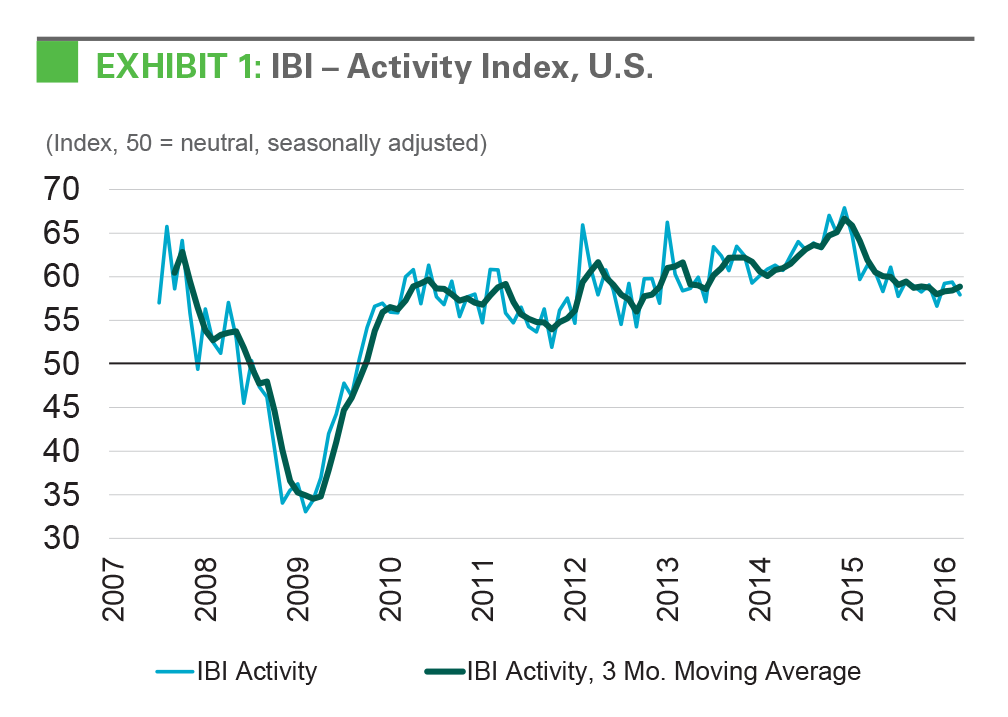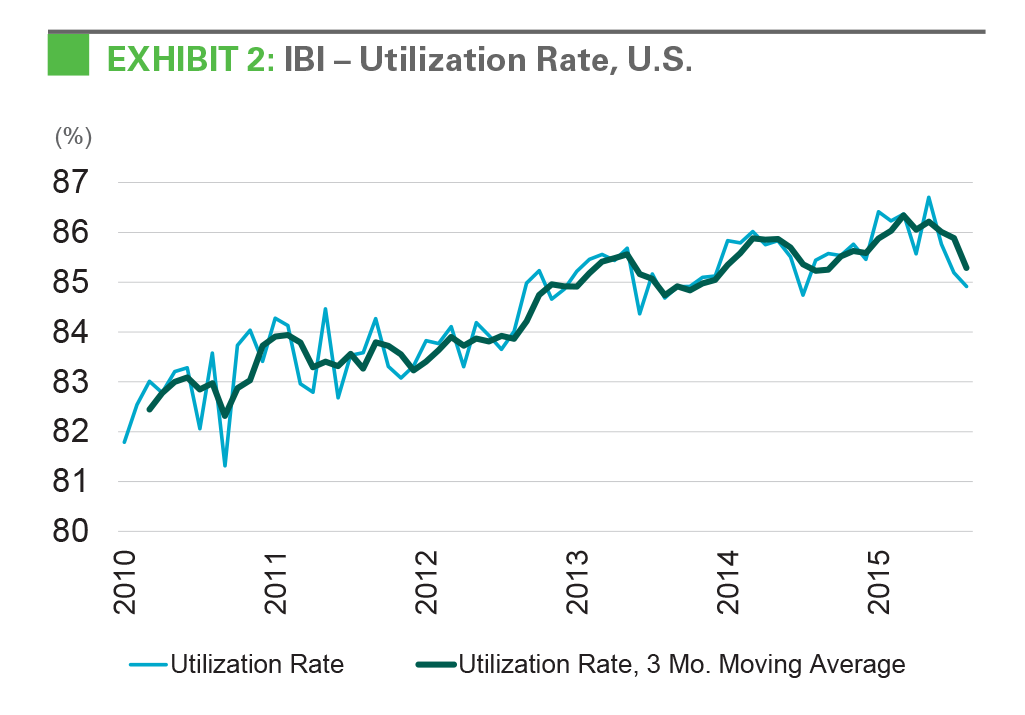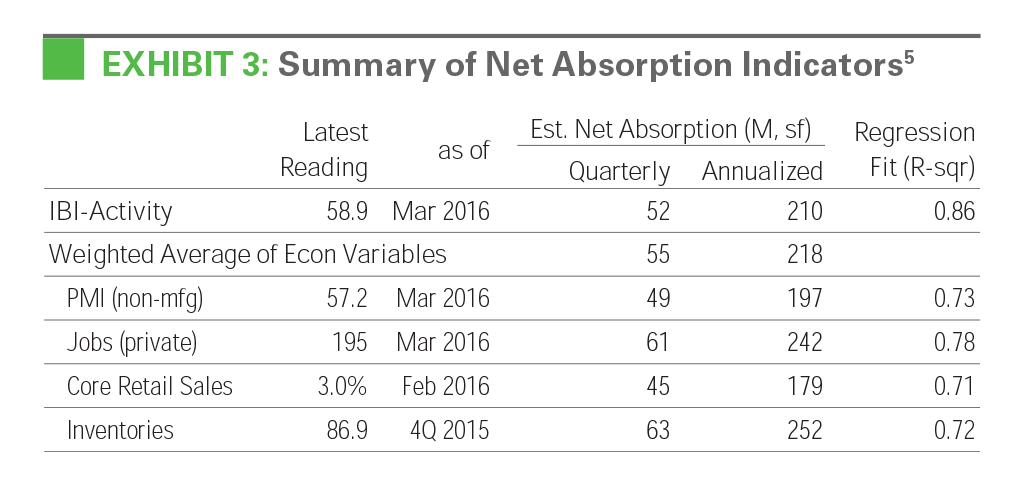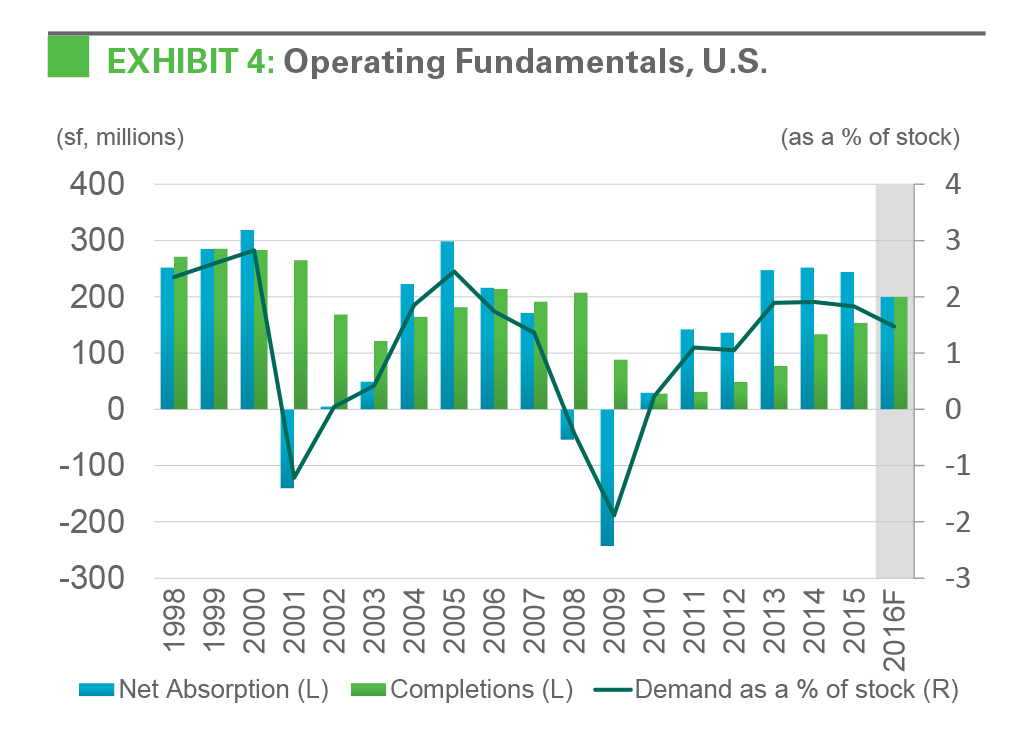
PROLOGIS U.S. INDUSTRIAL BUSINESS INDICATOR™
Logistics real estate occupiers further expanded their footprints through the first quarter of 2016 despite recent volatility in the financial markets and the global economy. The latest reading from Prologis’ proprietary index of customer activity, the U.S. Industrial Business Indicator™ (IBI), reveals healthy growth and an elevated utilization of space. Net absorption reached 60 million square feet in the first quarter of 2016.1Up 18 percent year-over-year, this above-trend level of absorption illustrates the outperformance of industrial demand relative to economic drivers.
With a foundation built on U.S. consumption and ongoing structural tailwinds such as the rise of e-commerce, the outlook for logistics real estate fundamentals suggests that the scarcity of available space could persist. Development activity continued to lag demand, leading the vacancy rate to a new cyclical low of 5.6 percent. Logistics real estate customers are finding it difficult to secure space. Given heightened competition for space, rents are increasing. Taking into account continued expansion and global economic uncertainty, Prologis Research forecasts net absorption of 200 million square feet in 2016. We expect completions to roughly match demand by year-end 2016. Balanced demand and supply would keep the vacancy rate near its multi-cycle low.
Customers’ businesses are expanding at a normal pace. The IBI customer activity index reading was 57.9 in March, reflecting normal growth consistent with the need for new logistics space (Exhibit 1). Readings above 50 indicate growth, and customer sentiment has remained in line with a maturing economic expansion through early 2016. Our survey is in line with economist expectations for GDP growth in the low 2 percent range through 2017, driven largely by higher consumer spending.2 Given that a sizable base of the logistics real estate occupier universe is dedicated to serving consumers’ daily needs, this outlook is consistent with a normal level of anticipated future demand.

Utilization rates have been exceptionally high and are showing signs of an expected easing. Prologis Research expected an eventual decrease in space utilization as the natural byproduct of customers’ leasing new space as existing facilities reach capacity. The national utilization rate hit a record 86.7 percent in December 2015 and has since declined-typical after the holiday season (Exhibit 2). However, a slight year-over-year decrease in the utilization rate suggests that the decline may not be entirely seasonal but a combined product of seasonality and expansion into new space. The 12-month moving average utilization rate remains near a record high.

Retail remains a source of strength. Retail customers reported the highest customer activity reading in March, further underscoring strength in domestic consumption. Customer activity readings surpassed 60 across all industries. Of note, activity readings for manufacturing industry customers rebounded in early 2016—a positive surprise.
Economic indicators support improved customer sentiment. After a volatile second half of 2015, macroeconomic indicators now reflect an environment more consistent with logistics real estate demand and IBI customer activity readings. Job creation was robust in the first quarter, and consumer confidence is elevated.3 Low unemployment is beginning to fuel wage growth.4 These factors drive consumer spending, which forms the foundation of logistics real estate demand. Furthermore, structural shifts persist independent of the economic cycle, such as e-commerce and the continued reconfiguration of domestic supply chains, augmenting demand.
Logistics real estate demand will likely maintain its momentum in 2016. Our models correspond with net absorption velocity of about 180 to 250 million square feet annualized, based on recent macroeconomic data (Exhibit 3). Yet, lingering economic uncertainty and recent industrial demand outperformance could portend an eventual downshift. Therefore, Prologis Research projects 200 million square feet of net absorption and 200 million square feet of completions in 2016 (Exhibit 4).


Persistent low vacancy should keep the leasing environment competitive. Our forecast of demand-supply equilibrium would keep the national vacancy rate near its current cyclical low through 2016. Heightened customer competition for limited space should keep upward pressure on rental rates, which, after growing 25 percent in the last three years, should rise at a more moderate pace. This outlook underscores the need for customers to continue to plan ahead for upcoming space requirements. Rent growth exceeding inflation and sustained high occupancy should propel robust NOI gains as leases roll and are marked to market in the coming years.
ENDNOTES
- CBRE-EA
- Consensus Economics
- U.S. Bureau of Labor Statistics, University of Michigan
- U.S. Bureau of Labor Statistics
- Based upon 15-year regression analyses, with data when available, using an auto-regressive process. IBI and PMI are the three-month moving average index levels. Jobs series is the three-month moving average change for private sector employment in thousands. Core retail sales (ex. autos and gasoline) are yr/yr growth in the three-month moving average. Private inventories change is quarterly in billions of 2009 dollars. The weighted average is based on R-squareds.
FORWARD LOOKING STATEMENTS
This material should not be construed as an offer to sell or the solicitation of an offer to buy any security. We are not soliciting any action based on this material. It is for the general information of customers of Prologis.
This report is based, in part, on public information that we consider reliable, but we do not represent that it is accurate or complete, and it should not be relied on as such. No representation is given with respect to the accuracy or completeness of the information herein. Opinions expressed are our current opinions as of the date appearing on this report only. Prologis disclaims any and all liability relating to this report, including, without limitation, any express or implied representations or warranties for statements or errors contained in, or omissions from, this report.
Any estimates, projections or predictions given in this report are intended to be forward-looking statements. Although we believe that the expectations in such forward-looking statements are reasonable, we can give no assurance that any forward-looking statements will prove to be correct. Such estimates are subject to actual known and unknown risks, uncertainties and other factors that could cause actual results to differ materially from those projected. These forward-looking statements speak only as of the date of this report. We expressly disclaim any obligation or undertaking to update or revise any forward-looking statement contained herein to reflect any change in our expectations or any change in circumstances upon which such statement is based.
No part of this material may be (i) copied, photocopied, or duplicated in any form by any means or (ii) redistributed without the prior written consent of Prologis.
PROLOGIS RESEARCH
Prologis’ research department studies fundamental and investment trends and Prologis’ customers’ needs to assist in identifying opportunities and avoiding risk across four continents. The team contributes to investment decisions and long-term strategic initiatives, in addition to publishing white papers and other research reports. Prologis publishes research on the market dynamics impacting Prologis’ customers’ businesses, including global supply chain issues and developments in the logistics and real estate industries. Prologis’ dedicated research team works collaboratively with all company departments to help guide Prologis’ market entry, expansion, acquisition and development strategies.
ABOUT PROLOGIS
Prologis, Inc. is the global leader in industrial real estate. As of December 31, 2015, Prologis owned or had investments in, on a wholly owned basis or through co-investment ventures, properties and development projects expected to total approximately 669 million square feet (62 million square meters) in 20 countries. The company leases modern distribution facilities to more than 5,200 customers, including third-party logistics providers, transportation companies, retailers and manufacturers.


